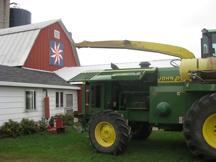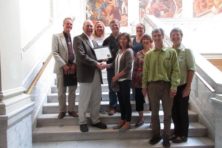Historic Structures as a Means for Art
- Share
- Tweet
- Pin
- Share

Barn Owned By: Richard and Eric Olson Farm, 580 County Road S, Sturgeon Bay
Quilt Pattern: North Star
Barn Type: Gambrel built in 1872, Century Farm.
Painted By: Algoma FFA
I am a lover of barns, and living in a place like Door County with a strong agricultural history has only fueled that obsession. However, I had never thought about the side of a barn as a space for artwork – until I was told about the Kewaunee Barn Quilts Project.
The idea for the Barn Quilts project was inspired by a project of a similar focus in Sac County, Iowa.
“A woman in my 4-H club, Kathy Janosky, got the whole thing rolling,” says Kathy LaCrosse, who served as one of the coordinators of the project and is also the Kewaunee County 4-H Adult Leader. “Kathy had brought in a newspaper from her hometown in Iowa and had mentioned that Kewaunee County should do something similar. I thought it was a cool idea but knew that I just didn’t have the resources to do a project of this magnitude.”
The next day, LaCrosse got a phone call from Jennifer Gozdzialski, who was a Kewaunee County neighbor as well as the Volunteer Director of the Agricultural Heritage & Resources Center, a non-profit organization dedicated to promoting the agricultural heritage of Brown, Door, Kewaunee, and Manitowoc Counties.

Barn Owned By: Lynn Schiesser, E7214 Kennedy Road, Algoma
Quilt Pattern: Clay’s Choice
Barn Type: German, Century Farm
Painted By: Bells of Luxemburg 4-H club
“She had talked to the same woman I had talked to, and after talking about it further, we decided to do it,” says LaCrosse.
LaCrosse and Gozdzialski teamed up with Jill Jorgensen, the Kewaunee 4-H Youth Leadership Development Coordinator, and, after receiving a partial grant from the Wisconsin Arts Board, plans were made to begin the project.
At the beginning, the committee only knew “we wanted to concentrate on barns that were a bit hidden – on the outskirts,” says LaCrosse. “I knew that I wanted our barn to be one of them, and so did Jennifer, but other than that, we didn’t know who we should ask.”
The project committee put an ad in the Kewaunee County newspaper, which brought them a few more interested people – but they soon realized that they might have to knock on doors and explain the project in a little more detail.
“One older woman kept asking me, ‘So, you’re putting quilts on these barns?’ I had to keep reassuring people that these were plywood quilts – not the real thing!”
Twelve barns were initially chosen, with the scope of the project eventually expanding to 18, and the majority of the barn properties being in Kewaunee County. A few of the barns are also located in the counties of Manitowoc, Brown, and Door.

Barn Owned By: Kathy and Ray Janosky, E4036 County Road FF, Kewaunee
Quilt Pattern: Blazing Star
Barn Type: German
Painted By: Janosky Family
Once the barns had been selected, a kick-off meeting was held in November 2008. Well, kind of.
“We had a person who was going to speak about quilt patterns, another one was going to speak about colors, and we had someone else that was going speak about the heritage of old barns,” LaCrosse says. “We were so excited…and then the power went out.” The committee decided to let groups meet with barn owners on their own, and let these groups figure out the quilt patterns and colors they’d like on their barns.
The project was met with a lot of excitement – from community members of all ages.
“We had everyone from the youth and adult 4-H Club, FFA (Future Farmers of America) and FFA Alumni members, as well as families who wanted to paint one of the quilt squares together,” says LaCrosse. “It was cool to see all of these people – ages and backgrounds from all parts of the spectrum – excited about the same project.”
While the patterns seem pretty straightforward, LaCrosse admits that it was a harder than it appeared to be.

Barn Owned By: Eugene and Jennifer Gozdzialski, N4886 Hwy 42, Kewaunee
Quilt Pattern: Liberty Star
Barn Type: 1800’s Lutheran Barn
Painted By: Meadow Moovers 4-H club
“We obtained most of the patterns from the Sac County project,” LaCrosse says, “but we did still have to adapt those patterns to 8’x 8’ plywood squares. With one inch of the pattern equaling one foot of the barn quilt, there were some major mathematics involved.” And, because the plywood quilts were assembled in two equal pieces, “you prayed they would match up when you pushed the halves together,” laughs LaCrosse.
Because of the countless hours spent organizing, decision-making, priming, and painting, LaCrosse and the other committee members gave themselves a modest deadline, creating the quilt panels over the winter months and planning to display them at the 2009 Kewaunee County Fair. However, the energy of the project wasn’t modest – and resulted in the project being done months ahead of schedule. “Everyone kept telling us that these were way too cool to be kept in storage until July,” LaCrosse says. “So we decided to put them up early.”
The hanging of the quilts took place in February 2009, a day the meteorologist predicted one to two inches of snow to fall during the course of the afternoon. By the time six of the quilts had been hung, 14 inches of powder covered the ground – and three more quilts were hung the following Tuesday in the freezing rain. “We didn’t have the best luck with weather,” LaCrosse smiles. The rest of the quilts were hung in June.
Each of the barn quilts have their own stories and symbols based on the period the barn was built and what the barn was used for, but for LaCrosse, the most rewarding part of the project was something she didn’t expect.
“My sons were just as focused as I was about finding potential barns to put ‘quilts’ on,” she says. “We weren’t just doing a project – we were teaching our kids about our heritage.”
To learn more about the Kewaunee Barn Quilt project, or to download a map of the 18 Barn Quilt locations, visit http://agriculturalheritage.org/barnquilts/.

